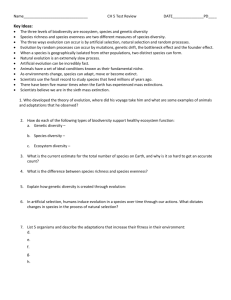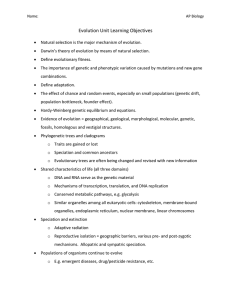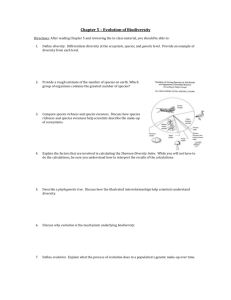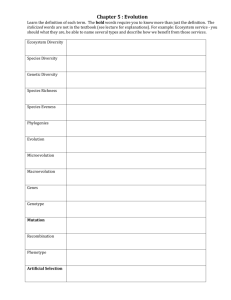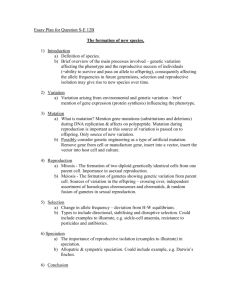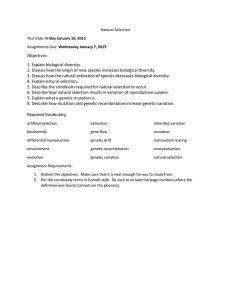Friedland & Relyea AP Env. Sci. apes ch5 chapter 5 Study Guide by C. Ridley
advertisement
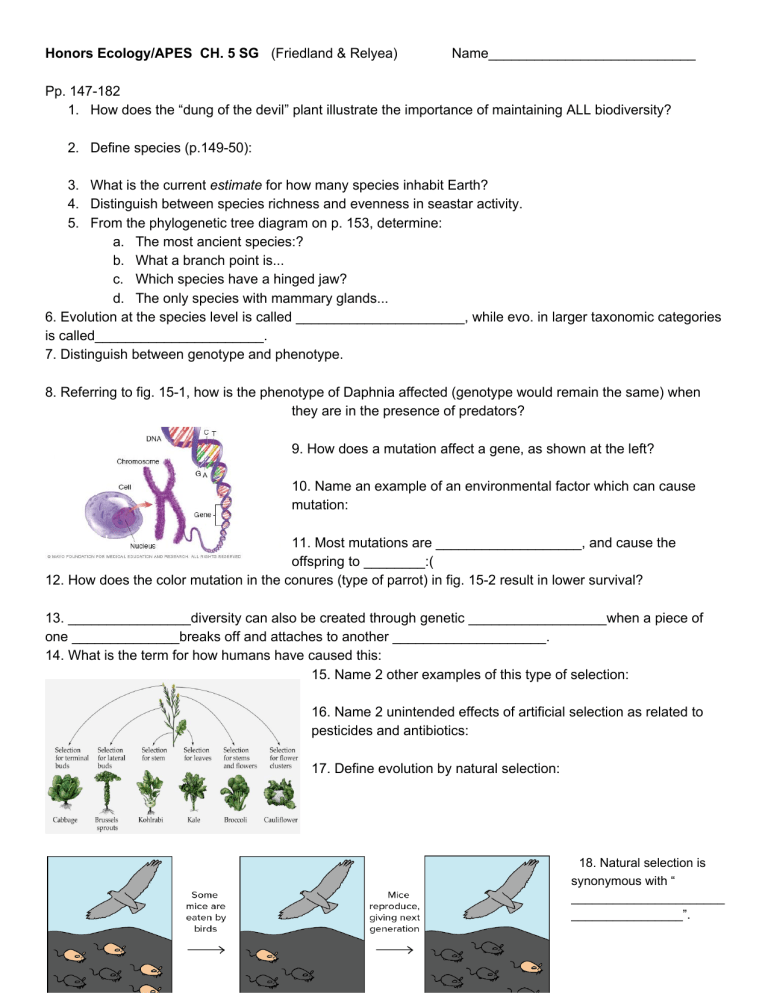
Honors Ecology/APES CH. 5 SG (Friedland & Relyea) Name___________________________ Pp. 147-182 1. How does the “dung of the devil” plant illustrate the importance of maintaining ALL biodiversity? 2. Define species (p.149-50): 3. What is the current estimate for how many species inhabit Earth? 4. Distinguish between species richness and evenness in seastar activity. 5. From the phylogenetic tree diagram on p. 153, determine: a. The most ancient species:? b. What a branch point is... c. Which species have a hinged jaw? d. The only species with mammary glands... 6. Evolution at the species level is called ______________________, while evo. in larger taxonomic categories is called______________________. 7. Distinguish between genotype and phenotype. 8. Referring to fig. 15-1, how is the phenotype of Daphnia affected (genotype would remain the same) when they are in the presence of predators? 9. How does a mutation affect a gene, as shown at the left? 10. Name an example of an environmental factor which can cause mutation: 11. Most mutations are ___________________, and cause the offspring to ________:( 12. How does the color mutation in the conures (type of parrot) in fig. 15-2 result in lower survival? 13. ________________diversity can also be created through genetic __________________when a piece of one ______________breaks off and attaches to another ____________________. 14. What is the term for how humans have caused this: 15. Name 2 other examples of this type of selection: 16. Name 2 unintended effects of artificial selection as related to pesticides and antibiotics: 17. Define evolution by natural selection: 18. Natural selection is synonymous with “ ______________________ ________________”. 19. The assumptions imbedded in the theory include: a. More offspring (an excess) are produced than will _________________ in the environment. b. Individuals differ in their _______________(physical AND behavioral). c. These differences can be ____________________ from parents to offspring (through DNA). d. Differences in traits are associated with differences in the ability to _______________and ________________ (the definition of FITNESS!) 20. Traits which improve an organism’s fitness are called _________________________. 21. Evolution can also occur through _______________processes. There are 5 random processes: ______________, ___________________, ___________________,________________, and ____________________. 22. When individuals move from one population (of a species) to another population, they are esentially changing the ________________composition of both populations. This process is called __________ _________. 23. Genetic drift is a change in the _____________ composition of a population as a result of ______________ __________ (or another chance event). 24. When a population undergoes a drastic reduction in size (such as in the black-footed ferrets :( ), this reduces the genetic _______________in a population, which is called the _________________effect. A population with limited genetic diversity such as this will be less likely to be able to cope with adverse (harmful) conditions. 25. Name 2 problems which can be caused from low genetic variation: 1. 2. *Remember that the variety of genes within a pop. is called genetic variation! 26. From figure 15-8, name a few problems in the Florida panthers which resulted from their low gen. div.: 27. How did scientists try to increase the genetic diversity in the FL panthers? 28. Refer to figure 15-11. How did the bird population on the island change as a result of the founder effect? 29. Geographic isolation can lead to ____________________speciation. An example of this is: 30. Speciation that occurs without a physical barrier is ____________________speciation. An example of this is: 31. An example of rapid evolution in a short period of time is seen in the ______________________fishes of Africa. Evidence indicates that _______species evolved from a single ancestral species. 32. Define GMO: 33. An organism’s role/job in its ecosystem is referred to as its _____________. The actual set of abiotic conditions under which it can survive, grow, and reproduce is its _____________________ niche, while the actual observed niche within which it lives is its ___________________niche (remember the barnacle example). 34. Use this diagram on the left and figure 17-1 to write these categories a. Survive, grow, and reproduce b. Survive and grow c. survive 35. Distinguish between a niche generalist and a niche specialist.
